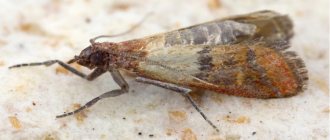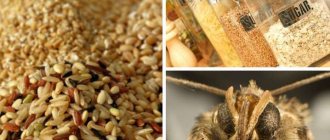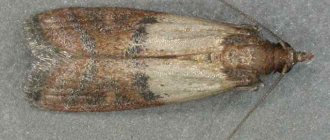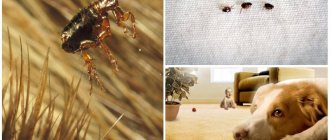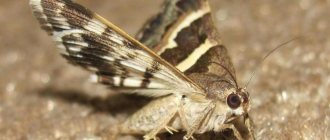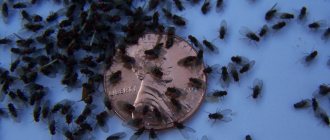Hi all!
If you've ever had food moths in your kitchen, you probably know how difficult it is to get rid of this pest. These insects lay their eggs in food, from which, after a couple of weeks, voracious larvae emerge, spoiling your food.
These parasitic insects can be found in both dirty and exceptionally clean kitchens. However, measures to exterminate them should be taken immediately as soon as you notice a gray-brown moth lazily flying past you. In this article I will tell you in more detail what food moth is, where it comes from, whether it is dangerous and what will help in its destruction.
What is food moth?
Externally, the kitchen moth looks like a small butterfly. Its size reaches a centimeter. The color of the wings is gray or brown. This makes it inconspicuous and allows you to hide among the products.
The insect lives for about a month and is extremely prolific. During its life cycle, it can lay many larvae in a variety of places.
The larvae of food moths look like motionless worms of white, milky or pinkish color, or light beige shades. The length can reach from 2 to 10 mm. The outer surface of the larvae is smooth and dense. Nests can be found in cereals and other groceries.
After the incubation period, small caterpillars emerge from the larvae. They begin to actively grow and develop, so they eat the food around them and spread further and further from the nest.
The caterpillar damages food by eating it and leaving excrement. Gradually, the individual’s skin hardens and a dense cocoon is formed – a pupa. By this period, the caterpillar should crawl closer to the light. She loses her skin and turns into a butterfly.
The emerging young moth immediately begins to fly from place to place, looking for places to lay larvae. The kitchen is the most attractive place for breeding. The room is always warm, there is high humidity and there is a lot of food. During the 4-6 weeks of its life cycle, the butterfly is capable of laying more than a hundred larvae.
Reviews
Positive reviews are written by people who use moth balls. After all, aerosols and sprayed liquids require additional cleaning after use. Balls without containers or in plastic are easy to use and work flawlessly.
The insect actually dies and the larvae disappear. Even a buyer from the Czech Republic spoke about the Clean House Extra product. He wrote: “A very strong and effective remedy for moths. Does a good job."
People respond positively after using cedar and sandalwood balls against moths. “They are very convenient and effective to use. The composition contains natural substances that smell pleasant,” they write.
How harmful is food moth?
Flying moths are not dangerous. The harm from it is expressed as follows:
- May get into food. Such food is not suitable for consumption.
- Larvae contaminate food.
- Threat of spreading infection. Contaminated food can cause allergies, intestinal disorders or intoxication.
- The appearance of moths raises thoughts about the presence of parasites in food. Such thoughts are fraught with psychological discomfort.
Harm to humans
Many people often confuse food moths with clothes moths. In fact, an insect that feeds on food supplies does not spoil things and does not bite. But the harm to a person from being next to an uninvited guest is no less:
- The voracious larvae live for about 2 months. During this time, they change their skin several times and actively devour grocery products, leaving behind microscopic feces.
- One butterfly lays more than 100 eggs, so contamination of stocks occurs very quickly - every day the amount of waste from the larvae increases exponentially.
- Caterpillars of food moths feed on almost all bulk supplies. Their diet includes flour, cereals, tea, cocoa, peas, beans, pasta, dried fruits, sesame seeds, dried mushrooms and even hot ground pepper. Once in a container with one type of product, pests will very quickly spread to other groceries.
- Products spoiled by food moths should not be eaten. Otherwise, a person faces intoxication of the body, upset stomach and intestines, weakened immunity, and allergic reactions.
The appearance of food moths in household supplies makes them unsuitable for consumption, since sifting or washing will be ineffective.
The voracious moth caterpillars cannot be contained by plastic, polyethylene or cling film. The only barrier to their spread is glass and metal.
How to detect
If unpleasant flying neighbors appear in the kitchen, then you need to start auditing your food supplies. In order to get rid of insects, you need to look through the cereals and try to find the nest.
In the photo of the food moth you can see where and in what way it makes its nests. The future army of adults is concentrated in them. When visually inspecting small cereals or flour, you should pay attention to lumps and pellets.
In cereals and other groceries, fragments intertwined with thin cobwebs may be found. The larvae are located in such lumps.
Small caterpillars can be found on the walls of containers where food is stored.
Food moths prefer to nest in the kitchen:
- In containers and bags with cereals and pasta;
- In bread bins;
- In jars for storing mild spices;
- Packaged with sugar or flour.
Features of using balls
Moth balls come in the form of white rounds. They are laid out in several pieces on closet shelves, as well as in the pockets of winter clothes, in gauze napkins or plastic containers. Particular attention should be paid to the remote corners of the far shelves where boxes with winter shoes are stored; balls will definitely have to be laid out there.
One package of balls is laid out in a large closet. If the cabinet does not open often, the drug should be replaced after 5-6 months with a new one, increasing the number of balls by several pieces. Boxes containing woolen items and winter shoes should be inspected and then closed again. Don't forget to put a moth ball in each box. Air must circulate freely inside the cabinet so that the fumes from the moth balls can penetrate into the most remote corners.
Methods of disposal
Destruction of a butterfly, larvae or caterpillars individually is a short-term measure. Only comprehensive measures will help get rid of the pest. It is necessary to destroy flying butterflies and nesting sites at the same time. This is the only way to stop the pest invasion.
There are effective ways to quickly get rid of food moths in the kitchen.
- If nests are found in grocery storage areas, you should immediately throw away the supplies as quickly as possible. They are no longer suitable for human consumption. There is no need to skimp on products. A larva may remain in any of them, which will become a source of new individuals.
- If, after a visual inspection, no signs of moth infestation are found in food packages, then preventive measures must be taken. Cereals are calcined in the oven at a temperature of about 60 degrees. Flour, sugar, pasta are taken out into the cold for a day.
- Absolutely all food must be removed from the cabinets. Internal surfaces should be treated with any food moth repellent. The cabinets are left open for several days, then washed with soapy water and ventilated again. Only after this procedure can you fill the shelves with supplies.
- In order to get rid of flying moths, you can use fly sticks. Butterflies stick to it and lose the ability to move.
- Special preparations are available for sale. These are sections filled with chemical compounds containing insect poison. Anti-moth tablets that are placed on shelves are effective. Larvae and caterpillars die from the smell.
- During long-term storage, products should be periodically taken out into the cold. It is necessary to ventilate cabinets more often.
Aerosols are not recommended as they will spoil the food.
Advantages and disadvantages
During the evaporation of the product used, the smell of lavender is released, as well as substances that have a detrimental effect on the reproduction of butterflies (butterflies lose the ability to lay eggs). Moth larvae and previously laid eggs are also destroyed. The period of action of the balls is up to six months; when completely evaporated, replace them with new ones. Positive qualities include convenient use.
A negative characteristic may be the evaporation and smell of lavender. The fumes from the drug are harmful to humans and can cause allergies. Individual intolerance to lavender may also be a contraindication for use. These contraindications include the smell of mothballs.
Important! Moth balls should be used strictly according to the instructions and work with gloves. After carrying out work, wash your hands with soap.
Folk remedies against moths
People's advice offers options on how to get rid of food moths. It does not tolerate strong spicy odors, so it is recommended to use:
- Dry lavender. Bunches of dried flowers are laid out in cabinets. The butterfly flies away from the places where the dry bouquet will be placed;
- The aroma of tansy and wormwood repels moths. This smell is not tolerated not only by moths, but also by small house ants;
- Fresh dill is effective in the fight against moths. Bunches of greenery hung in the closet drive away moths. They need to be changed every three to four days;
- Blooming geraniums on the kitchen windowsill will protect the room from pest invasion.
Prevention
- Moths enter the apartment from outside. Therefore, you need to carefully consider product packaging when purchasing. The presence of lumps and unknown inclusions in a grocery product is a reason to refuse the product.
- Food supplies must be checked periodically and cupboards must be ventilated.
- The interior surfaces of shelves and cabinets should be wiped with water and vinegar.
- There is no need to make large reserves. They should be replenished as needed.
- For storage, you must use a special sealed container.
All of the above methods tell you how to get rid of food moths. But still, the best option is to carry out timely prevention.
And at the first sign of the appearance of a pest, immediately launch a comprehensive counterattack.
Reasons for appearance
I have already mentioned that moths do not fly very well, which excludes the possibility of this moth entering your home from another apartment, warehouse, etc. What is the reason for the appearance of this butterfly in this case?
Let's start with the fact that the eggs and larvae of this insect live in industrial grocery stores. There, checking products for such defects is a rare occurrence, especially if the product is inexpensive. As a rule, the larvae simply travel along with the products from one warehouse to another, where the products are then packaged and sent to stores.
In this simple way, infected groceries get into your warm and cozy home, where the moth begins to unfold its vigorous life activity.

